1997 GMC SIERRA check engine
[x] Cancel search: check enginePage 392 of 436
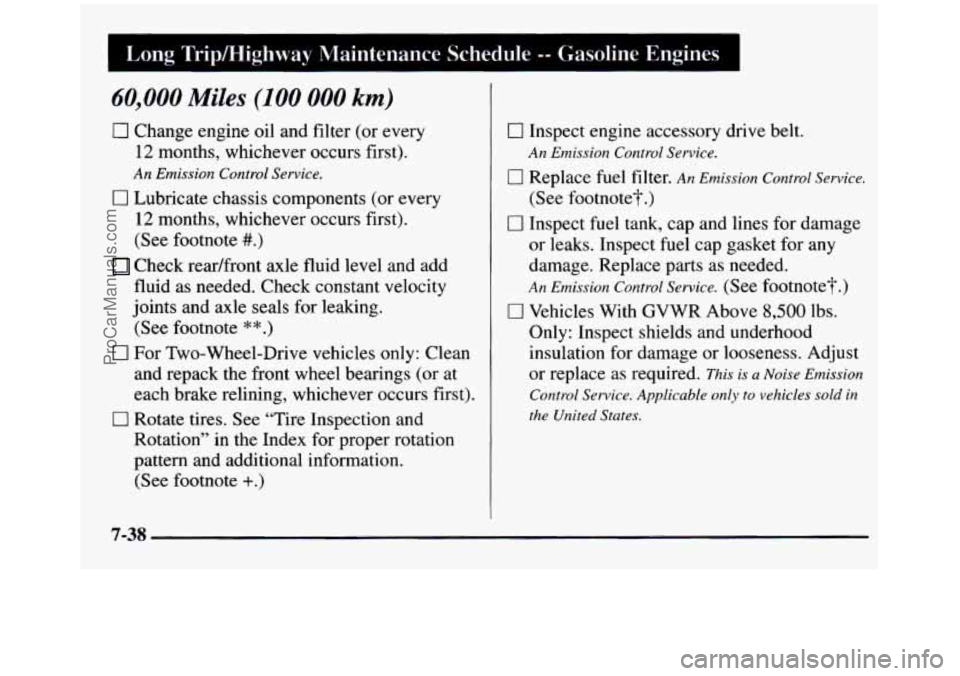
I Long Trip/Highway Maintenance Schedule -- Gasoline Engines I -
60,000 Miles (100 000 km)
0 Change engine oil and filter (or every
12 months, whichever occurs first).
An Emission Control Service.
0 Lubricate chassis components (or every
12 months, whichever occurs first).
(See footnote
#.)
Check readfront axle fluid level and add
fluid as needed. Check constant velocity
joints and axle seals for leaking.
(See footnote
**.)
0 For Two-Wheel-Drive vehicles only: Clean
and repack the front wheel bearings (or at
each brake relining, whichever occurs first).
0 Rotate tires. See “Tire Inspection and
Rotation” in the Index for proper rotation
pattern and additional information.
(See footnote
+.)
0 Inspect engine accessory drive belt.
0 Replace fuel filter. An Emission Control Service.
(See footnote?.)
0 Inspect fuel tank, cap and lines for damage
or leaks. Inspect fuel cap gasket for any
damage. Replace parts
as needed.
An Emission Control Service. (See footnote?.)
0 Vehicles With GVWR Above 8,500 lbs.
Only: Inspect shields and underhood
insulation for damage or looseness. Adjust
or replace as required.
This is a Noise Emission
Control Service. Applicable only
to vehicles sold in
the United States.
An
Emission Control Service.
7-38
ProCarManuals.com
Page 393 of 436
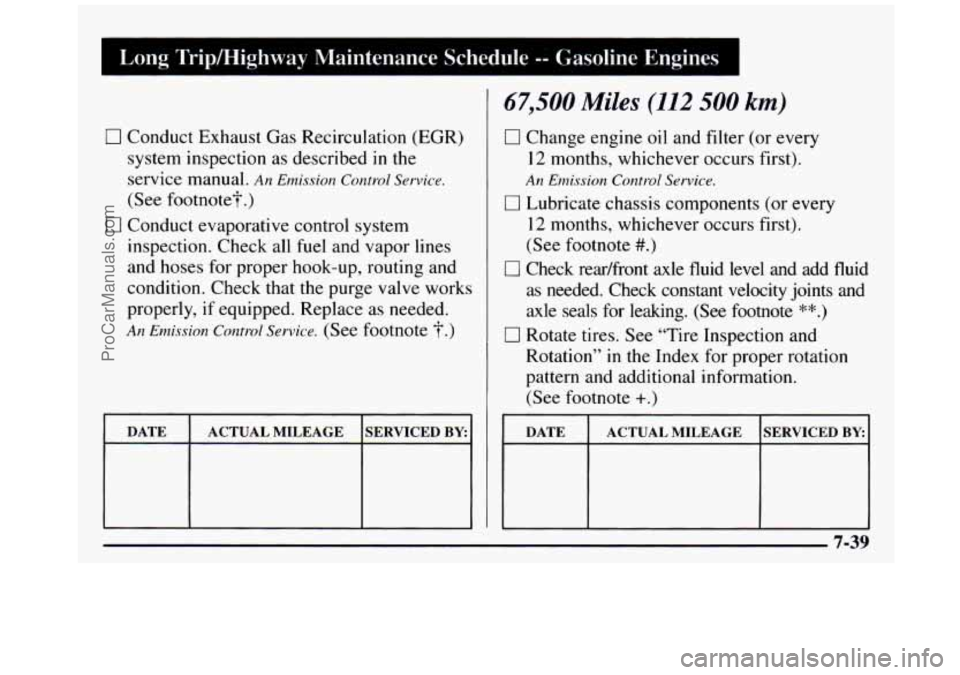
Long Tripmighway Maintenance Schedule -- Gasoline Engines I
0 Conduct Exhaust Gas Recirculation (EGR)
system inspection as described
in the
service manual.
An Emission Corztrol Service.
(See footnote?.)
inspection. Check all
fuel and vapor lines
and hoses for proper hook-up, routing and
condition. Check that the purge valve works
properly,
if equipped. Replace as needed.
An Emission Control Service. (See footnote ?.)
0 Conduct evaporative control system
DATE
SERVICED BY ACTUAL MILEAGE
67,500 Miles (112 500 km)
0 Change engine oil and filter (or every
12 months, whichever occurs first).
0 Lubricate chassis components (or every
12 months, whichever occurs first).
(See footnote
#.)
0 Check readfront axle fluid level and add fluid
as needed. Check constant velocity joints and
axle seals for leaking. (See footnote
**.)
0 Rotate tires. See “Tire Inspection and
Rotation”
in the Index for proper rotation
pattern and additional information. (See footnote
+.)
An Emission Control Service.
I DATE I ACTUALMILEAGE I SERVICED BY I
7-39
ProCarManuals.com
Page 394 of 436
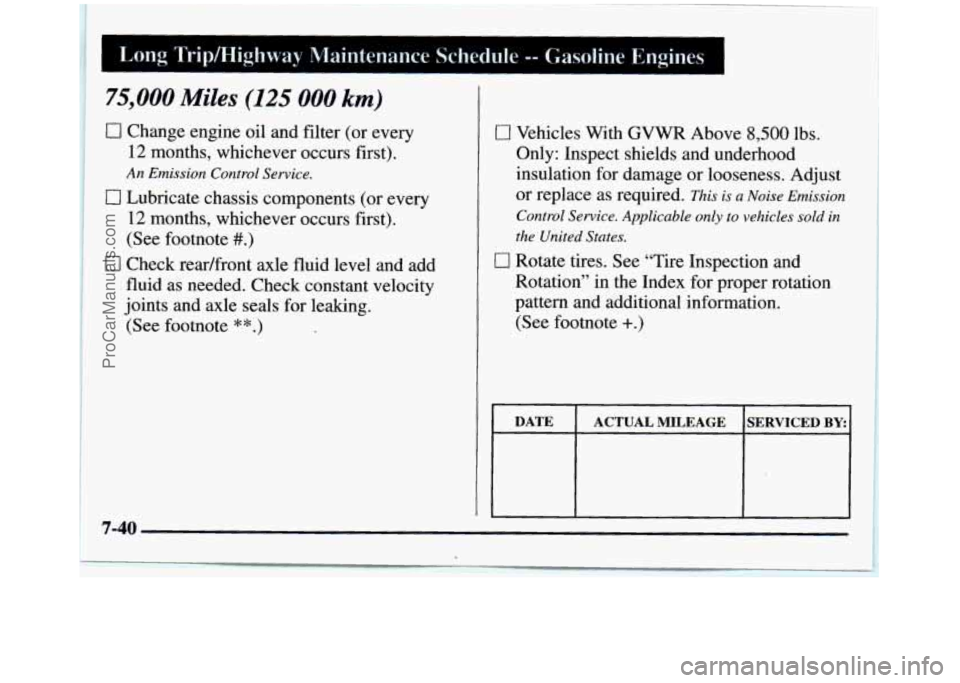
Long Trip/Highway Maintenance Schedule -- Gasoline Engines
75,000 Miles (125 000 km)
0 Change engine oil and filter (or every
12 months, whichever occurs first).
Cl Lubricate chassis components (or every
12 months, whichever occurs first).
(See footnote
#.)
0 Check readfront axle fluid level and add
fluid
as needed. Check constant velocity
joints and axle seals for leaking.
(See footnote
* * .)
An Emission Control Service.
0 Vehicles With GVWR Above 8,500 lbs.
Only: Inspect shields and underhood
insulation for damage or looseness. Adjust
or replace as required.
This is a Noise Emission
Control Service. Applicable only to vehicles sold in
the United States.
0 Rotate tires. See “Tire Inspection and
Rotation” in the Index for proper rotation
pattern and additional information.
(See footnote
+.)
DATE ACTUAL MILEAGE SERVICED BY
7-40
ProCarManuals.com
Page 395 of 436

1 Long Tripmighway Maintenance Schedule -- Gasoline Engines 1
82,500 Miles (137 500 km)
0 Change engine oil and filter (or every
12 months, whichever occurs first).
0 Lubricate chassis components (or every
12 months, whichever occurs first).
(See footnote
#.)
0 Check readfront axle fluid level and add fluid
as needed. Check constant velocity joints and
axle seals for leaking. (See footnote
* *.)
0 Rotate tires. See “Tire Inspection and
Rotation”
in the Index for proper rotation
pattern and additional information.
(See footnote
+.)
An Emission Control Service.
90,000 Miles (150 000 km)
0 Change engine oil and filter (or every
12 months, whichever occurs first).
An Emi.rsiorz Control Service.
17 Lubricate chassis components (or every
12 months, whichever occurs first).
(See footnote
#.)
0 Check readfront axle fluid level and add
fluid as needed. Check constant velocity
joints and axle seals for leaking.
(See footnote
**.)
For Two-Wheel-Drive vehicles only: Clean
and repack
the front wheel bearings (or at
each brake relining, whichever occurs first).
(Continued)
7-41
ProCarManuals.com
Page 396 of 436
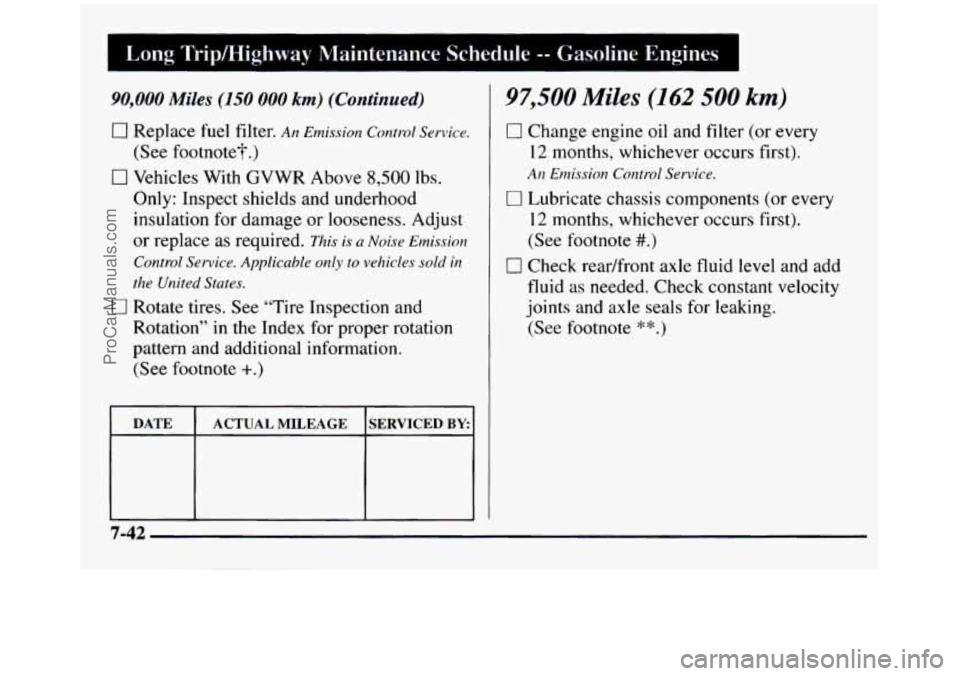
I Long Tripmighway Maintenance Schedule -- Gasoline Engines
90,000 Miles (150 000 km) (Continued)
0 Replace fuel filter. An Emission Control Service.
(See footnote?.)
0 Vehicles With GVWR Above 8,500 lbs.
Only: Inspect shields and underhood
insulation for damage or looseness. Adjust
or replace as required.
This is a Noise Emission
Control Service. Applicable
only to vehicles sold in
the United States.
0 Rotate tires. See “Tire Inspection and
Rotation”
in the Index for proper rotation
pattern and additional information.
(See footnote
+.)
97,500 Miles (162 500 km)
0 Change engine oil and filter (or every
12 months, whichever occurs first).
An Emission Control Service.
0 Lubricate chassis components (or every
12 months, whichever occurs first).
(See footnote
#.)
0 Check readfront axle fluid level and add
fluid
as needed. Check constant velocity
joints and axle seals for leaking.
(See footnote
**.)
-.
DATE ACTUAL MILEAGE SERVICED BY
7-42
ProCarManuals.com
Page 399 of 436
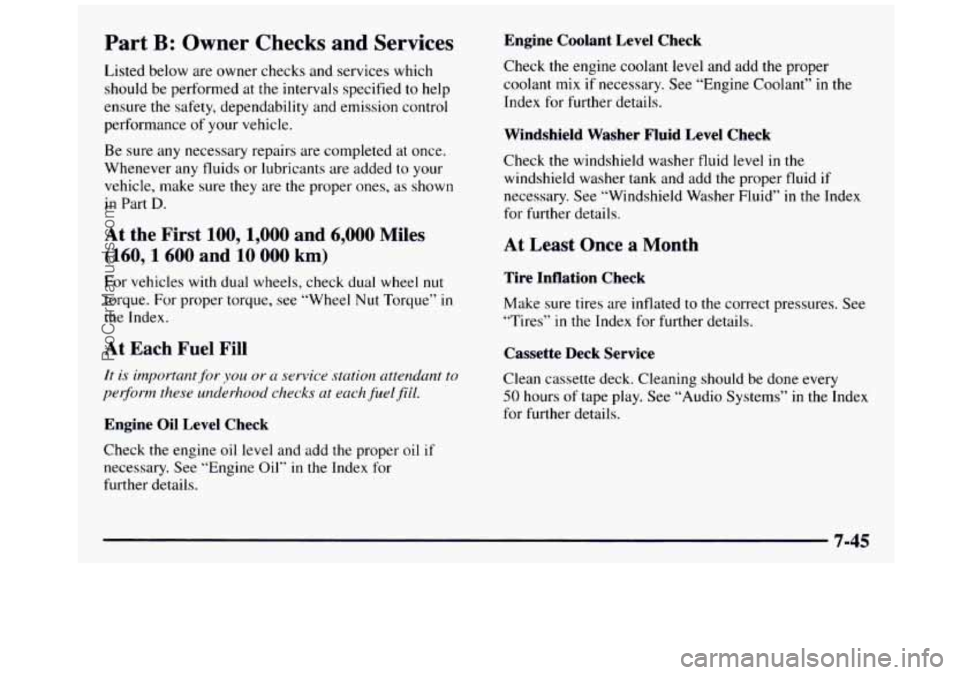
Part B: Owner Checks and Services
Listed below are owner checks and services which
should be performed at the intervals specified
to help
ensure the safety, dependability and emission control
performance
of your vehicle.
Be sure any necessary repairs are completed at once.
Whenever any fluids or lubricants are added
to your
vehicle, make sure they are the proper ones,
as shown
in Part
D.
At the First 100, 1,000 and 6,000 Miles
(160,1600 and 10 000 km)
For vehicles with dual wheels, check dual wheel nut
torque. For proper torque, see “Wheel Nut Torque” in
the Index.
At Each Fuel Fill
It is important for you or ~1 service station attendant to
per$orm these underhood
checks ut eachjbtelfiE1.
Engine Oil Level Check Engine Coolant Level Check
Check the
engine coolant level and add the proper
coolant mix if necessary. See “Engine Coolant’’ in the
Index for further details.
Windshield Washer Fluid Level Check
Check the windshield washer fluid level in the
windshield washer tank and add
the proper fluid if
necessary. See “Windshield Washer Fluid”
in the Index
for further details.
At Least Once a Month
Tire Inflation Check
Make sure tires are inflated to the correct pressures. See
“Tires”
in the Index for further details.
Cassette Deck Service
Clean cassette deck. Cleaning should be done every
50 hours of tape play. See “Audio Systems” in the Index
for further details.
Check
the engine oil level and add the proper oil if
necessary. See “Engine Oil” in the Index for
further details.
7-45
ProCarManuals.com
Page 400 of 436
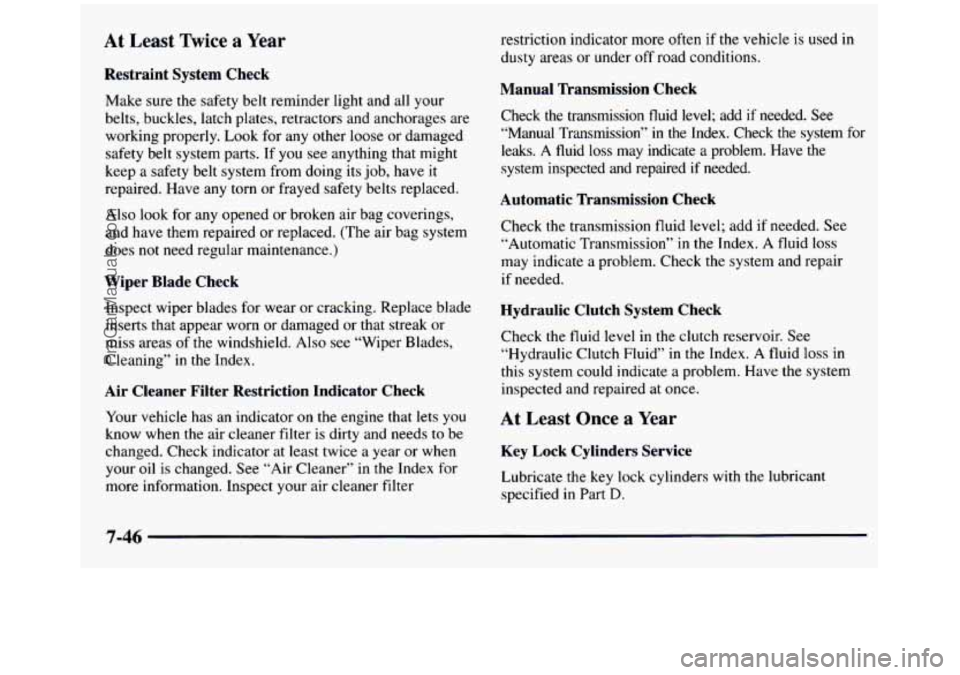
At Least Twice a Year
Restraint System Check
Make sure the safety belt reminder light and all your
belts, buckles,
latch plates, retractors and anchorages are
working properly. Look for any other loose or damaged
safety belt system
parts. If you see anything that might
keep a safety belt system from doing its job, have it
repaired. Have any torn or frayed safety belts replaced.
Also look for any opened or broken air bag coverings,
and have them repaired or replaced. (The air bag system
does
not need regular maintenance.)
Wiper Blade Check
Inspect wiper blades for wear or cracking. Replace blade
inserts that appear worn or damaged or that streak or
miss areas of the windshield. Also see “Wiper Blades,
Cleaning” in the Index.
Air Cleaner Filter Restriction Indicator Check
Your vehicle has an indicator on the engine that lets you
know when the air cleaner filter is dirty and needs
to be
changed. Check indicator at least twice a year or when
your oil is changed. See “Air Cleaner” in
the Index for
more information. Inspect your air cleaner filter restriction indicator more often
if the vehicle is used in
dusty areas or under off road conditions.
Manual Transmission Check
Check the transmission fluid level; add if needed. See
“Manual Transmission” in
the Index. Check the system for
leaks. A fluid loss may indicate a problem. Have the
system inspected and repaired if needed.
Automatic Transmission Check
Check the transmission fluid level; add if needed. See
“Automatic Transmission” in the Index.
A fluid loss
may indicate a problem. Check the system and repair
if needed.
Hydraulic Clutch System Check
Check the fluid level in the clutch reservoir. See
“Hydraulic Clutch Fluid” in the Index. A fluid loss in
this system could indicate a problem. Have the system
inspected and repaired
at once.
At Least Once a Year
Key Lock Cylinders Service
Lubricate the key lock cylinders with the lubricant
specified
in Part D.
7-46
ProCarManuals.com
Page 401 of 436
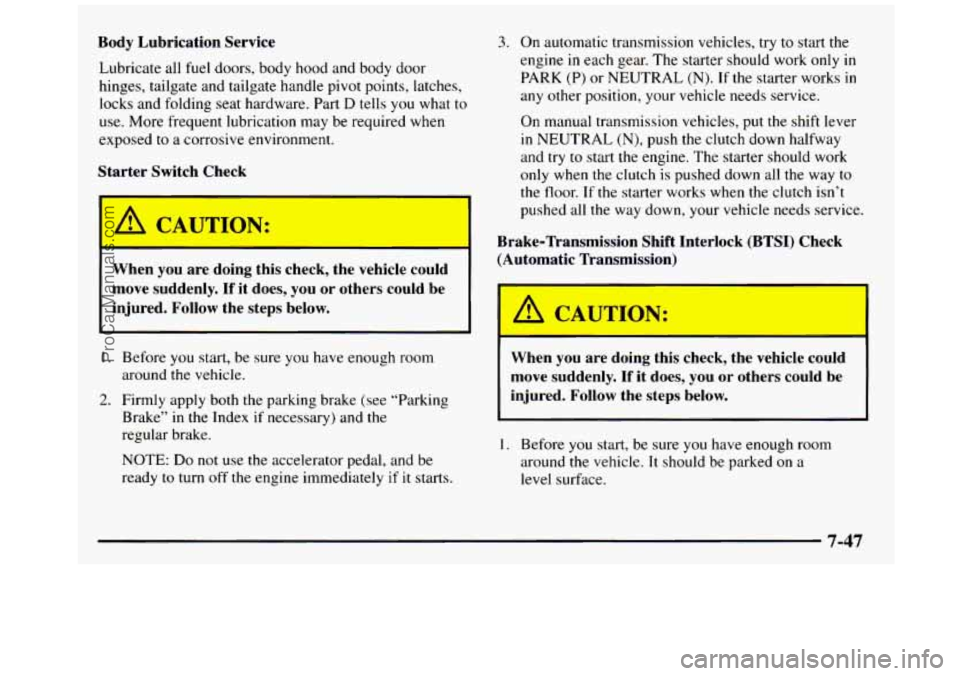
Body Lubrication Service
Lubricate all fuel doors, body hood and body door
hinges, tailgate and tailgate handle pivot points, latches,
locks and folding seat hardware. Part
D tells you what to
use. More frequent lubrication may be required when
exposed
to a corrosive environment.
Starter Switch Check
’ A CAUTION:
When you are doing this check, the vehicle could
move suddenly.
If it does, you or others could be
injured. Follow the steps below.
3. On automatic transmission vehicles, try to start the
engine
in each gear. The starter should work only in
PARK (P) or NEUTRAL (N). If the starter works in
any other position, your vehicle needs service.
On manual transmission vehicles, put
the shift lever
in NEUTRAL (N), push the clutch down halfway
and try
to start the engine. The starter should work
only when the clutch
is pushed down all the way to
the floor. If the starter works when the clutch isn’t
pushed all the way down, your vehicle needs service.
1. Before you start, be sure you have enough room
2. Firmly apply both the parking brake (see “Parking
around the vehicle.
Brake” in
the Index if necessary) and the
regular brake.
NOTE: Do not use the accelerator pedal, and be
ready
to turn off the engine immediately if it starts.
Brake-’Ikansmission Shift Interlock (BTSI) Check
(Automatic Transmission)
I A CAUTION:
When you are doing this check, the vehicle could
move suddenly. If it does,
you or others could be
injured. Follow the steps below.
1. Before you start, be sure you have enough room
around the vehicle. It should be parked on a
level surface.
7-47
ProCarManuals.com